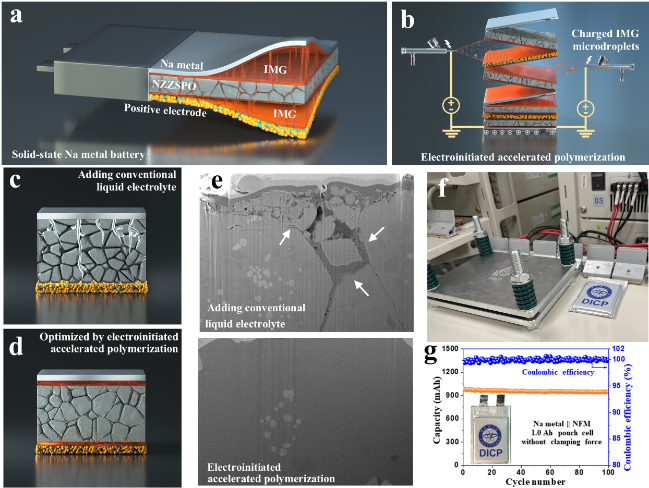Solid-state batteries have emerged as one of the most promising next-generation energy storage technologies due to their high energy density and intrinsic safety. However, their practical application remains hindered by poor interfacial contact and instability between the solid electrolyte and the metal anode.

Interfacial modification strategy for Ah-level external pressure-free solid-state sodium metal batteries based on oxide solid-state electrolytes (Image by YANG Tingzhou)
Recently, in a study published in Nature Communications, a research team led by Prof. CHEN Zhongwei from the Dalian Institute of Chemical Physics (DICP) of the Chinese Academy of Sciences (CAS) has developed a new interfacial engineering strategy that enables external pressure-free solid-state sodium metal batteries, marking a major advance toward scalable and durable all-solid-state systems.
Among solid electrolytes, oxide-based electrolytes exhibit high ionic conductivity and chemical stability, but their intrinsic brittleness often leads to microcracks and pores during fabrication and operation. Moreover, poor wettability, high interfacial resistance, and side reactions during long-term cycling can further trigger dendrite penetration and interfacial failure. These issues severely hinder ion transport and battery reliability, making interfacial regulation and stabilization a central scientific challenge in solid-state battery development.
To address these issues, the researchers proposed an innovative electrically induced accelerated polymerization strategy for interfacial repair. By introducing charged repair adhesive microdroplets, which undergo rapid polymerization under an electric field — 21.4 times faster than conventional methods — the process leverages the electrowetting effect to form a uniform interfacial coating that preferentially fills cracks and enhances interfacial contact.
This strategy improves the stability between metallic sodium and the solid electrolyte, effectively preventing dendrite-induced crack propagation. As a result, the modified system achieved a critical current density of 6.8 mA cm-2 and sustained stable cycling over 1,000 cycles at 1.0 C.
Furthermore, pouch-type solid-state sodium metal batteries constructed with this interfacial repair strategy maintained outstanding long-term cycling stability without external stack pressure, demonstrating its scalability and practical potential for next-generation energy storage.